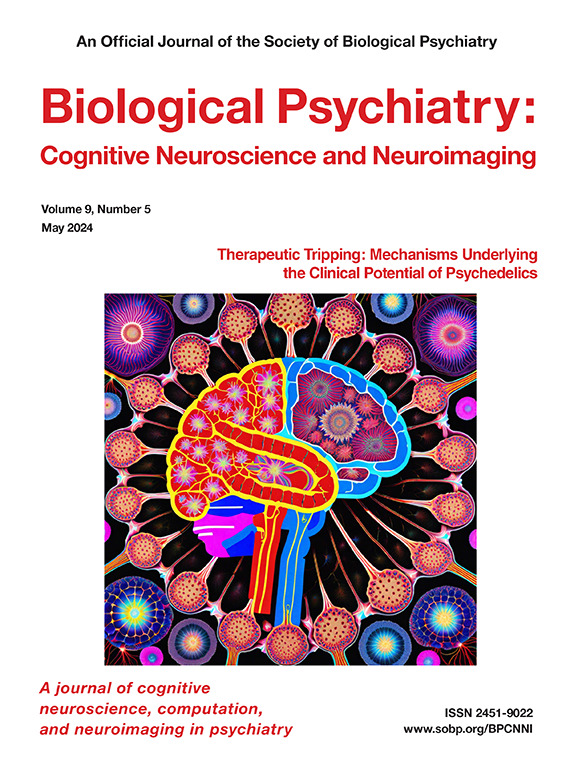非侵入性脑刺激增强平静:正念干预的新框架。
IF 4.8
2区 医学
Q1 NEUROSCIENCES
Biological Psychiatry-Cognitive Neuroscience and Neuroimaging
Pub Date : 2025-04-01
DOI:10.1016/j.bpsc.2024.12.005
引用次数: 0
摘要
正念因其对心理健康、认知表现和幸福的益处而获得了广泛的认可。然而,正念的多面性,包括注意力集中、情绪调节和当下意识等元素,使其定义和测量变得复杂。其广泛益处的一个关键组成部分可能是平静——对所有感官体验保持开放和无反应态度的能力。实证研究表明,正念通过自上而下的注意力控制和自下而上的感觉和情绪过程的结合而起作用,而平静在调节这些自下而上的过程中的作用驱动了心理和生理上的益处,使其成为理论和实践探索的一个有希望的目标。鉴于这些发现,专门增强平静的干预措施的发展可以改善正念练习的影响。对非侵入性脑刺激(NIBS)的研究表明,它是一种潜在的工具,可以改变与正念有关的神经回路。然而,迄今为止,大多数NIBS研究都集中在改善认知控制系统上,而对平静的探索相对较少。针对后扣带皮层(PCC)的聚焦超声干预的初步结果表明,NIBS可以通过抑制默认模式网络(DMN)中的自我参照加工,直接促进平静,从而促进更以现在为中心的意识状态。未来的研究应优先考虑将NIBS与明确的正念训练协议相结合,并将平静作为核心目标。这种方法可以为推进冥想神经科学和临床应用提供一个新的框架,为正念机制和完善NIBS方法提供新的见解,以支持个性化、精确的健康干预。本文章由计算机程序翻译,如有差异,请以英文原文为准。
Enhancing Equanimity With Noninvasive Brain Stimulation: A Novel Framework for Mindfulness Interventions
Mindfulness has gained widespread recognition for its benefits for mental health, cognitive performance, and well-being. However, the multifaceted nature of mindfulness, which encompasses elements such as attentional focus, emotional regulation, and present-moment awareness, complicates its definition and measurement. A key component that may underlie its broad benefits is equanimity—the ability to maintain an open and nonreactive attitude toward all sensory experiences. Empirical research suggests that mindfulness works through a combination of top-down attentional control and bottom-up sensory and emotional processes and that equanimity’s role in regulating those bottom-up processes drives the psychological and physiological benefits, making it a promising target for both theoretical and practical exploration. Given these findings, the development of interventions that specifically augment equanimity could improve the impact of mindfulness practices. Research into noninvasive brain stimulation (NIBS) suggests that it is a potential tool for altering neural circuits involved in mindfulness. However, most NIBS studies reported to date have focused on improving cognitive control systems and have left equanimity relatively unexplored. Preliminary findings from focused ultrasound interventions targeting the posterior cingulate cortex suggest that NIBS can directly facilitate equanimity by inhibiting self-referential processing in the default mode network to promote a more present-centered state of awareness. Future research should prioritize the integration of NIBS with well-defined mindfulness training protocols, focusing on equanimity as a core target. This approach could provide a novel framework for advancing both contemplative neuroscience and clinical applications, offering new insights into the mechanisms of mindfulness and refining NIBS methodologies to support individualized, precision wellness interventions.
求助全文
通过发布文献求助,成功后即可免费获取论文全文。
去求助
来源期刊

Biological Psychiatry-Cognitive Neuroscience and Neuroimaging
Neuroscience-Biological Psychiatry
CiteScore
10.40
自引率
1.70%
发文量
247
审稿时长
30 days
期刊介绍:
Biological Psychiatry: Cognitive Neuroscience and Neuroimaging is an official journal of the Society for Biological Psychiatry, whose purpose is to promote excellence in scientific research and education in fields that investigate the nature, causes, mechanisms, and treatments of disorders of thought, emotion, or behavior. In accord with this mission, this peer-reviewed, rapid-publication, international journal focuses on studies using the tools and constructs of cognitive neuroscience, including the full range of non-invasive neuroimaging and human extra- and intracranial physiological recording methodologies. It publishes both basic and clinical studies, including those that incorporate genetic data, pharmacological challenges, and computational modeling approaches. The journal publishes novel results of original research which represent an important new lead or significant impact on the field. Reviews and commentaries that focus on topics of current research and interest are also encouraged.
 求助内容:
求助内容: 应助结果提醒方式:
应助结果提醒方式:


